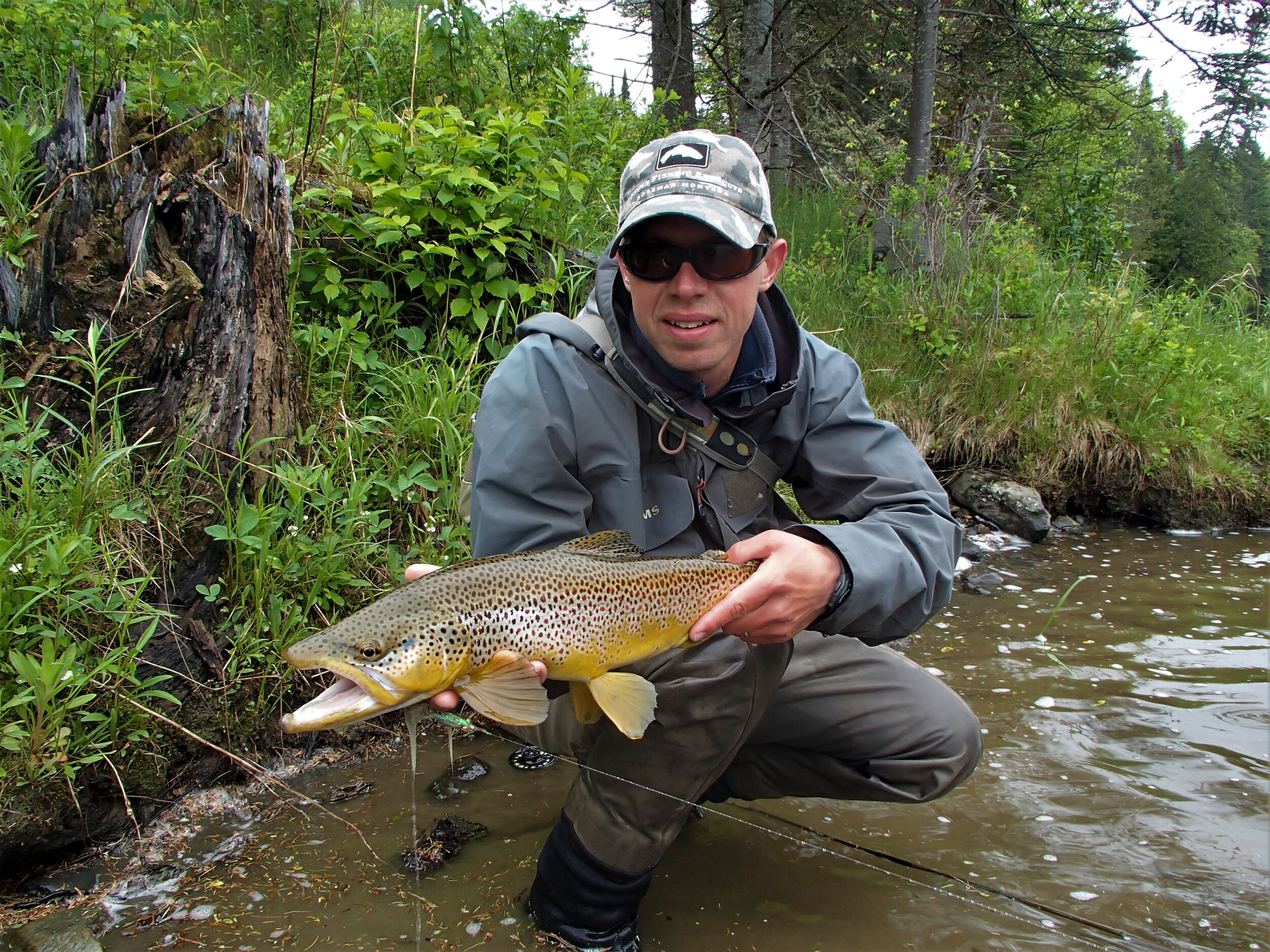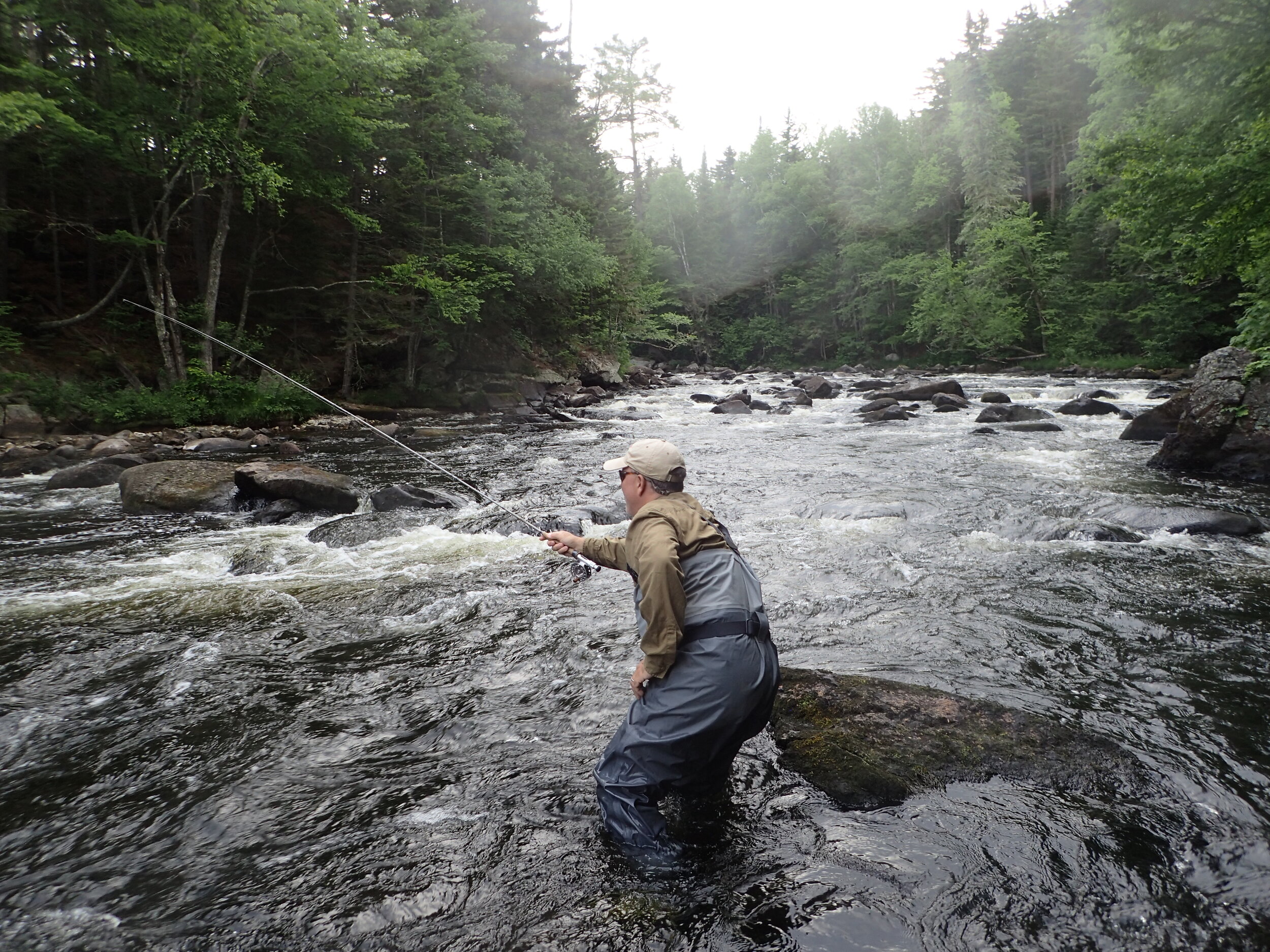Think about how to get your fly to the fish….and keep it there as long as possible.
I spend a lot of time scanning through the internet looking at fly-fishing information. I read blog posts, fishing reports, watch YouTube videos, and the like. I’m always interested in learning what other people have to think and share on the subject of fishing, or I’m looking for inspiration to motivate myself at the fly-tying bench. The other day I happened on an interesting article on the subject of streamer fishing, revolving around fishing enough weight to get one’s fly down to the fish. It was interesting because the article touched on a subject that was on my mind from a very recent fishing expedition. One in which the subject of weight played a major factor in the success of my day. While the article was well-done, I did find it to be an oversimplification of a subject that I find to be very important, and often not well understood in the realm of streamer fishing. So I am inspired to share some of my thoughts on a sometimes confusing subject of setups for streamer fishing, and how to balance line selection, fly patterns, and retrieves to maximize your success on the water.
I believe anglers must develop systems to be consistently successful on the water. No one fly pattern, fly line or leader setup will allow an angler to effectively fish every water type they encounter on a river, pond, or lake. Having a variety of fly patterns and equipment to choose from, and being able to identify when and where to use what setup, will greatly improve an anglers ability to catch fish under a variety of conditions.
Modern Streamers:
The rise in the popularity of “euro-nymphing” in recent years has introduced many fly fishermen to a more technical side of fishing that was previously unknown to most. As American anglers began to delve into the world of competitive fly angling, they found quickly that their skills were no match against anglers from other parts of the world. So they were forced to rethink how they approached fishing situations, and learn new tactics. This has given rise to some of the most skilled fly-anglers America has ever known. Lucky for the rest of us, these anglers have been happy to share their knowledge and skills through books, videos and other media.
The biggest lesson to be learned from competitive anglers, is that an angler needs to think about each situation before fishing. Be able to size up conditions, and make gear and fly selections based on what you see, and then approach a piece of water in the best way possible, to maximize one’s chance at success.
This method of critical-thinking has caught on with a lot of anglers, especially when it comes to nymph-fishing and throwing dry-flies. But I feel like many anglers still don’t apply this method of thinking when it comes to fishing streamer-flies.
Maine’s Rapid River is home to very large brook trout. The river’s runs and pools offer the challenge of being both very deep as well as having very swift current. To successfully fool the Rapid’s biggest trout on streamers requires an angler be able to present their flies to where the fish are holding.
For most of it’s history, streamer fishing was about swinging a fly down-and-across current on either a floating or sinking line. Let it swing, then strip it back. In 2000, Bob Linnseman and Kelly Galloup revolutionized streamer fishing with their book: “Modern Streamers for Trophy Trout”. This book taught anglers to trigger aggressive responses from big, predatory trout by throwing large flies on heavy sinking lines, and aggressively stripping them across currents to imitate wounded prey. Bob and Kelly’s ideas and techniques helped to modernize streamer fishing, and has helped countless anglers catch bigger fish and create streamer fishing addicts the world-over.
While the techniques and ideas pioneered by Bob and Kelly in their book were revolutionary and effective, they too are an oversimplification at times. A lot of anglers never get past the “big fly on a sinking line fished fast” mentality. Trout are not grizzly bears, and if you think that you can simply splat down a fly in an area where a big trout is sitting, and run the fly away at high-speed, and expect the big trout to run it down and eat, than you won’t catch as many big trout as you could if you broaden your thinking a little. Kelly, and other talented streamer anglers have expanded on these ideas in the 20 years since “Modern Streamers” first came out, and there is some really excellent material out there, but I feel like many anglers are missing out.
Friend and fellow guide Kris Thompson joined me for day of throwing streamers on foot during prime conditions one Spring day. These are the days streamer addicts dream of, when big flies fished aggressively draw arm-wrenching strikes from the biggest fish in the river. Reality is that there are very few days like this in a whole season, and most days it’s much harder to get the big fish to commit to eat. Taking the time to think through your presentation will help put more fish like this in your net, instead of just chucking-and-hoping.
To consistently and effectively catch big fish on streamers, anglers must expand their thinking, as they have done with other aspects of fly fishing. Most anglers will tell you they understand about having the proper weight, depth, and drift when nymph fishing, and that leader length and drift is critical for fishing dry-flies. So too must the same care be taken when fishing streamers. Anglers will carry multiple boxes of different weighted nymphs and spools of tippets, and fuss endlessly about “getting the right drift” on each little piece of water, but carry one sinking line and fish the same leader for all their streamer fishing on every body of water they go to. Having a variety of gear and streamers at one’s disposal, will greatly increase an anglers ability to approach different situations and conditions with success.
Factors to Consider:
While it is true that on occasion you can trigger a territorial response from a big fish by slamming a fly down on its head and running it away aggressively, the fact is that you will catch far more big fish by getting a fly down into the predator’s space, and keeping it there as long as possible. I feel it is better to trigger a feeding response as opposed to a territorial response. An easy meal dangling right in front of a fish’s face is a lot more likely to get eaten than a meal that runs away, under a greater variety of conditions. Under ideal conditions (high, off-colored water, low light, ideal temps) trout, especially brown trout, will move a long way to take prey items. Under these conditions one can fish aggressively and expect a lot of eats. But change even one of these conditions and suddenly the fish’s mood will change and those eats become follows and half-hearted swipes. This is when slowing it down, and giving a fish the option to feed on an easy meal becomes the best strategy. But to do this effectively, there are some factors anglers need to consider instead of just blindly chucking a sinking line and big fly.
A beautiful stretch of water on a big freestone river. The right-side bank is deep and dark. The water is slow, and cold. It’s important to consider these factors to make the correct presentation. Get it wrong in this clear water and you will never even know if that big brown trout was there…
Water temperature
Trout are cold-blooded. The single most important factor that determines their behavior is water temperature. Every species of trout has a “preferred” temperature range. This is a range of temperatures where the fish feels most comfortable and is the most active. Generally this falls between the mid 40’s and mid 60’s. In this range, the trout will move to intercept prey items. Above and below this range, the trout begins to experience physiological stress, and becomes lethargic. Trout will still feed, but are less likely to move any distance for food, and feeding windows during the day become shorter. To warm or to cold, and the trout will feed only during very brief periods, or may stop feeding all together. In fishing terms, the further the water temperature is away from the “preferred” range, the closer and slower the streamer must be presented to the fish. In reality, temperature is a far more complicated subject than my simple explanation here, but I offer this generalization to help give a basic understanding of how water temp plays a role in fishing.
Water speed
Speed of water flow is important to understand when presenting streamers, because it can determine how fish react to flies. Fish occupying faster water types have less time to inspect offerings, and must make a split second decision on whether to feed or pass on an offering. In slower water, fish can see flies from a greater distance, and have a much longer time to inspect potential prey. Fish in slow water may pounce on a fly immediately, or may follow for long distances before eating or not eating. Understanding how water speed affects fish behavior can help an angler make a selection in fly, leader and line combination to bring a fly to the appropriate level, and then maintain that level while moving a fly at the appropriate speed to elicit a strike.
Water depth
Large trout can occupy both shallow and deep water at any time of the year. Water depth is important mainly in its relationship to temperature and speed. Determining how the fish are likely to react based on water temp and water flow, will then allow an angler to make a setup choice to fish the depth of water they are encountering. An angler must choose a setup to effectively fish the appropriate depth of water at an appropriate speed. A good rule of thumb out there to follow is if the water temperature is within a trout’s preferred range, than a streamer needs to “split the difference” of the waters depth. This means the fly should be a minimum of half-way between the surface and the bottom. The further the temperature is away from the preferred range (whether cooler or warmer), the closer the fly should be to the bottom, where fish are holding.
Putting it together:
If anglers take the time to consider these factors while streamer fishing, it should become very evident very quickly that one cannot simply fish the same set-up through every water type encountered in a days fishing. Anglers need to make on-stream adjustments to more effectively cover the different water types encountered. Being able to manage and control one’s fly depth and speed is paramount to maximizing success.
Summer pocket-water is no place for a sinking line and light-weight fly patterns. The churning complex currents offer no control with a sinking line, and light flies get swept out of the small pockets where the fish hold. Weighted flies fished on longer leaders in conjunction with floating lines offer the angler maximum control, and the ability for streamers to drop into the strike zone without being swept away from the fish.
The key to all this is balance. Having the right combination of line, leader, and fly. Once an angler considers the three factors of water temp, speed, and depth, they must then choose a setup that allows them to bring the fly to the fish, and retrieve it at an effective speed to elicit a strike. A setup that is too heavy will hang bottom, or cause an angler to fish too fast to avoid hanging bottom. A setup that is too light may not get deep enough to elicit strikes from fish that are not willing to move a long distance to feed.
Anglers that predominantly wade-fish should consider carrying a variety of spare spools rigged with different grain sink-tip lines, or carry sinking poly-leaders in various lengths and weights. Couple this with a streamer box with confidence streamer patterns in various weights, and an angler is equipped to deal with most situations that they may encounter. A heavy sink-tip and weightless fly fishes the deep, slow pool effectively, but is easily swapped out to a floating line and long leader with weighted fly to fish pocket-water.
An early season float trip with Hill Country Guides resulted in this nice brown. Cold water in the Winter and early Spring often has fish glued to the bottom. This fish was on the drop-off in a very deep pool. A weighted streamer fished on a full-sink 300 grain line was the recipe for success. Above and below this pool are long stretches of shallow water, and the 300 grain is overkill, but in this instance it was the right tool for the job.
Anglers that fish from boats have the ability to carry more fly rods, rigged and ready to go. It is important when floating and covering a lot of water to be ready to swap if conditions change. Heavy full-sink lines are useful for fishing deep pools, or if there are sudden flow increases on a tailwater, but lighter options are necessary for the in-between shallow riffles, flats and banks. One cannot simply fish the same set-up and expect to effectively cover all the different water types one encounters when floating. Being able to swap between set-ups quickly is key to being more efficient when covering water quickly.
The bottom line:
At the start of this article I eluded to a recent fishing trip where weight proved to be of importance to the success of the day. A good friend and I decided to take advantage of a very nice winter’s day and float a local tailwater. Bright sunny weather, moderate flows, and cold water led us to suspect that the winning presentation would be nymphing deep, slow water. We packed a couple of streamer set-ups as more of an afterthought, but after several hours of no success with nymphs, we decided to switch to swinging small streamers. This method proved effective at producing some solid rainbows, and we ended up salvaging a decent day from what had been a slow one. What is important to note however, is that only one of the two setups we fished was effective. I had brought my very heavy full-sinking line, and my friend had brought his lighter sink-tip. Despite the deep, moderate current, my full-sink line was too much and I was routinely hooking bottom. My companions lighter sink-tip, coupled with a lightly weighted fly, proved to be the winning combination. His set-up was more balanced, and allowed for a deep, slow presentation, where the fly stayed in front of the fish and elicited strikes. My set-up was simply too heavy, even coupled with unweighted flies, and on the slow swing needed to trigger winter trout I simply would hang bottom. I feel it’s very important to note that in this case, it was a difference in set-up that meant the difference between catching a few fish and catching nothing at all.
Winter rainbows wanted small leech patterns swung slow and deep. Finding the right balance of sinking line and weighted fly meant the difference between catching fish and catching rocks!
The bottom line is to think critically about choosing set-ups for streamer fishing. Anglers that carry a variety of equipment and assortments of different weighted flies will be better prepared to deal with a variety of conditions they might encounter on the water. When approaching a piece of water, take the time to consider the water temperature, speed of flow, and water depth. Consider how the fish might react based on the prevailing conditions, and choose a presentation that most effectively fishes the conditions. Get your streamer to the fish, and keep it in front of them.
There are a lot of other factors that go into hunting big fish on streamers, beyond what I’ve covered here. But I think it’s important for anglers to recognize the importance of thinking critically about streamer fishing, and that there is more to streamer presentation than the “chuck-and-hope” method that many people employ. Think about the water you are fishing, and find the best setup to present your fly. This is the first step in becoming a better streamer angler, and will help you have more chances at some really big fish. Good luck.








